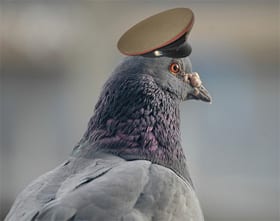
by Pigeon Patrol | May 14, 2022 | 4-S Gel Bird repellent, Animal Deterrent Products, Bird Deterrent Products, Bird Law, Bird Netting
A racing pigeon from
Belgium has set a new world record after being sold for more than £1.4million.
New Kim, a three-year-old female, was initially put up for auction for just €200, but after a two-week bidding war she fetched a staggering €1.6 million.
During a frantic last half-hour, two Chinese bidders operating under the pseudonyms of Super Duper and Hitman drove up the price by £251,000 (€280,000). Super Duper submitted the winning bid.
The bird’s breeder and owner Kurt Van de Wouwer said he and his family were “in shock” at the news.Nikolaas Gyselbrecht, founder of Pipa auction house for racing pigeons, shows off the prized birdThe final total left the previous record set by fellow Belgian-bred bird, Armando, trailing behind by around £314,000 (€350,000).
Armando, who was nicknamed the “
Lewis Hamilton of
pigeons” for his racing prowess, was retired when he was put up for sale in 2019.
New Kim won a number of competitions in 2018 but has also now retired.
Pigeon Patrol Products & Services is the leading manufacturer and distributor of bird deterrent (control) products in Canada. Pigeon Patrol products have solved pest bird problems in industrial, commercial, and residential settings since 2000, by using safe and humane bird deterrents with only bird and animal friendly solutions. At Pigeon Patrol, we manufacture and offer a variety of bird deterrents, ranging from Ultra-flex Bird Spikes with UV protection, Bird Netting, 4-S Bird Gel and the best Ultrasonic and audible sound devices on the market today.
Voted Best Canadian wholesaler for Bird Deterrent products ten years in a row.
Contact us at 1- 877– 4– NO-BIRD, (604) 585-9279 or visit our website at www.pigeonpatrol.ca
Pigeon/Pigeon Patrol / Pigeons Roosting / Vancouver Pigeon Control /Bird Spikes / Bird Control / Bird Deterrent / Pigeon Deterrent? Surrey Pigeon Control / Pest /Seagull deterrent / Vancouver Pigeon Blog / Birds Inside Home / Pigeons in the cities / Ice Pigeons/ What to do about pigeons/ sparrows , Damage by Sparrows, How To Keep Raccoons Away, Why Are Raccoons Considered Pests/ De-fence / Pigeon Nesting/ Bird Droppings / Pigeon Dropping/ woodpecker control/ Professional Bird Control Company/ Keep The Birds Away/ Birds/rats/ seagull/pigeon/woodpecker/ dove/sparrow/pidgeon control/pidgeon problem/ pidgeon control/flying rats/ pigeon Problems/ bird netting/bird gel/bird spray/bird nails/ bird guard
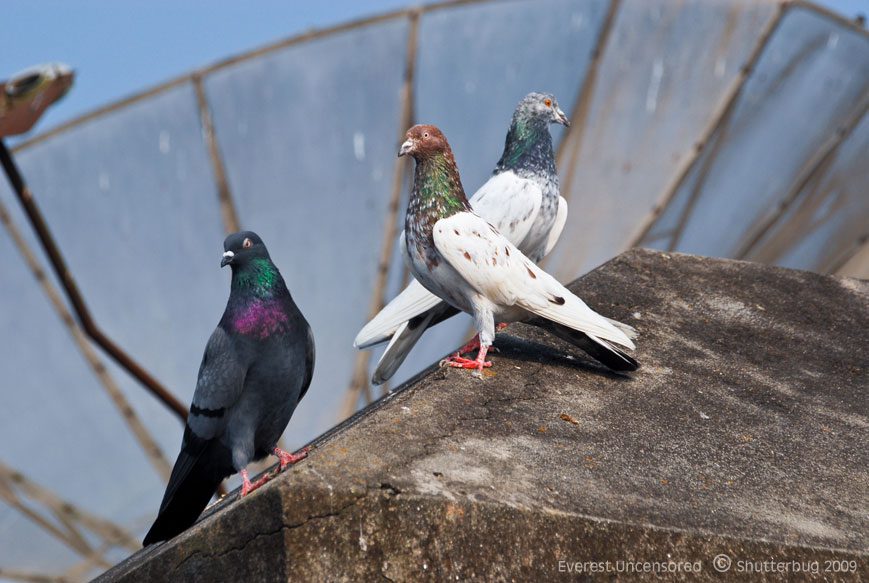
by Pigeon Patrol | Mar 29, 2022 | 4-S Gel Bird repellent, Animal Deterrent Products, Bird Deterrent Products, Bird Law, Bird Netting, Bird Spikes
Introduction
Growers often find bird nests around structures where food is washed, packaged, stored, and shipped. However, identification of these nests can be challenging. This article provides guidance on identifying nests of bird species commonly found nesting in barns, sheds, or other farm buildings. Most bird species included in this article are known to carry bacteria that cause food safety problems, such as pathogenic E. coli and Salmonella. However, some of these birds are also known to eat pest insects or rodents, so promoting nesting in appropriate areas can provide valuable natural pest control. Our article also makes recommendations for discouraging nesting in undesirable locations, such as food processing areas, and for promoting it elsewhere where birds can be primarily beneficial. We have organized the article by bird species that have invaded North America from Europe and Asia, and by species that are native to North America. Native species are protected under the Migratory Bird Treaty Act (MBTA) and cannot be harassed or have their nests tampered with.
Invasive Species
Figure 1. Group of European Starlings perched on a farm structure. Note the yellow bill and pinkish-orange legs that distinguish starlings from similar-looking native blackbirds. More identification information can be found online here. Photo credit: Olivia Smith.
The European Starling (hereinafter starling; Fig. 1) was introduced to Central Park in 1890 and 1891 by Shakespeare enthusiasts who wanted all of the birds in Shakespeare’s plays to be found in the park. If only they had never gone to the theater! After several unsuccessful releases, populations took off, and the starling has arguably become the most successful (and loathed) invasive bird species in North America. Though starlings are most numerous in human-dominated landscapes, they can be detrimental to native bird species due to competition for cavity nesting sites (Cabe, 1993). Although starlings do compete with more desirable native species for natural tree cavities, they have amazing flexibility in nest site selection and will also use cavities in structures (Fig. 2). Starlings construct nests inside of cavities with materials that can fall and dirty equipment or contaminate food with associated feces. Nests are easiest to locate by watching adults fly in and out of cavities. Starlings are known to vector pathogenic E. coli O157:H7 (Williams et al., 2011) and Salmonella enterica (Carlson et al., 2011; Kirk et al., 2002) and should be discouraged from nesting near food operations. Specific recommendations on starling nest management can be found here.
Starlings will begin choosing nest sites as early as February (Cabe, 1993) and can begin laying eggs between mid-March and mid-June, depending on latitude (Kessel, 1957). Birds typically lay around 4-5 eggs per clutch (a group of eggs) and have 1-2 broods (a group of nestlings hatched at the same time). Eggs are bluish or greenish white and approximately 2.7–3.2 cm long by 1.9–2.3 cm wide. Incubation generally takes 12 days (Ricklefs and Smeraski, 1983). Nestlings fledge (depart from the nest) on day 21–23 after hatching and typically continue to rely on the parents to supplement their food for 10–12 days (Cabe, 1993). Starlings are omnivorous (Wilman et al., 2014) and eat pest insects, predatory arthropods, and crops (Cabe, 1993; Somers, 2002). As with most bird species, the number of insects in the diet increases during the breeding season while chicks are growing and insect abundance is high (Cabe, 1993).
Similar to the story of the European Starling, the House Sparrow (Fig. 3) was introduced to North America in the 1850s and has now invaded all of North America. This species is highly associated with human-dominated landscapes. The House Sparrow has amazing nest site selection flexibility and can nest in nest boxes, inside and on buildings (Fig. 4), in stolen nests of other species (Fig. 3), or nest in and on trees. Intense competition for nesting cavities with native species can occur. Nests are constructed from a variety of materials such as dried plant material, feathers, or string. Like the European Starling, nests are most easily identified by watching birds fly to them (Lowther and Cink, 2006). Nest debris often accumulates under the nest location, causing food safety concerns when House Sparrows nest in food processing areas. This species is known to carry E. coli and Salmonella spp. (Morishita et al., 1999; Kirk et al., 2002) so should be discouraged from nesting near areas where food is present. Specific recommendations on House Sparrow nest management can be found here.
Figure 4. House Sparrow nests in barn rafters. Chicken wire was used to discourage nesting, but the sparrows were able to get under the netting. Photo credit: Olivia Smith.
Nest building begins in February and March, and egg laying begins in March. House Sparrows have amazing fecundity, can have 4–8 broods per season, and can lay between 1–8 eggs per clutch (average about 5 eggs). Eggs are oval; about 2.1 cm long by 1.6 cm wide; and white, greenish-white, or blueish-white with gray or brown spots. Birds begin incubation after laying the final egg of a clutch. Incubation generally lasts 10–14 days. Chicks generally fledge after 14 days. Fledglings independently feed themselves after 7–10 days (Lowther and Cink, 2006). Insects, including alfalfa weevils and other pests, comprise about 68% of the diet of young birds (Lowther and Cink, 2006), while adults are primarily granivorous, often consuming livestock feed (Wilman et al., 2014).
Rock Pigeon (Columba livia)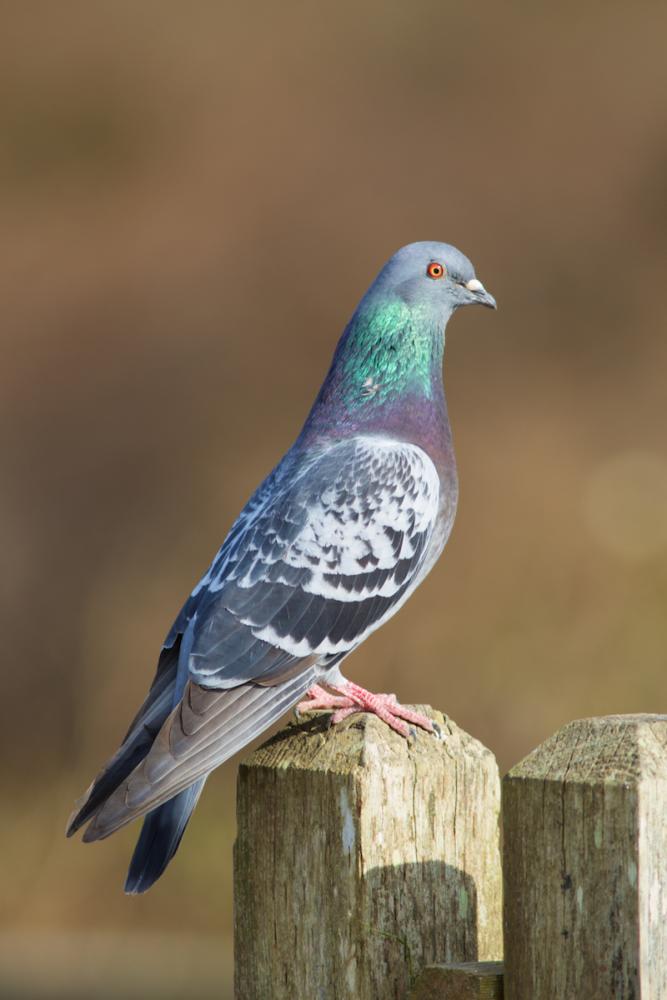
Domesticated Rock Pigeons were introduced into North America by Europeans in the 1600s and readily went feral. Like the common name Rock Pigeon implies, this species historically nested on cliffs and in caves, so ledges of modern human structures are quite suitable as long as flat surfaces occur (Fig. 5; Lowther and Johnston, 2014). Nests are typically flimsy constructions made of straw, stems, sticks, or human objects. Rock Pigeons are known to carry pathogenic E. coli (Kobayashi et al., 2009) and Salmonella enterica (Kirk et al., 2002) and should be discouraged from nesting near food processing areas.
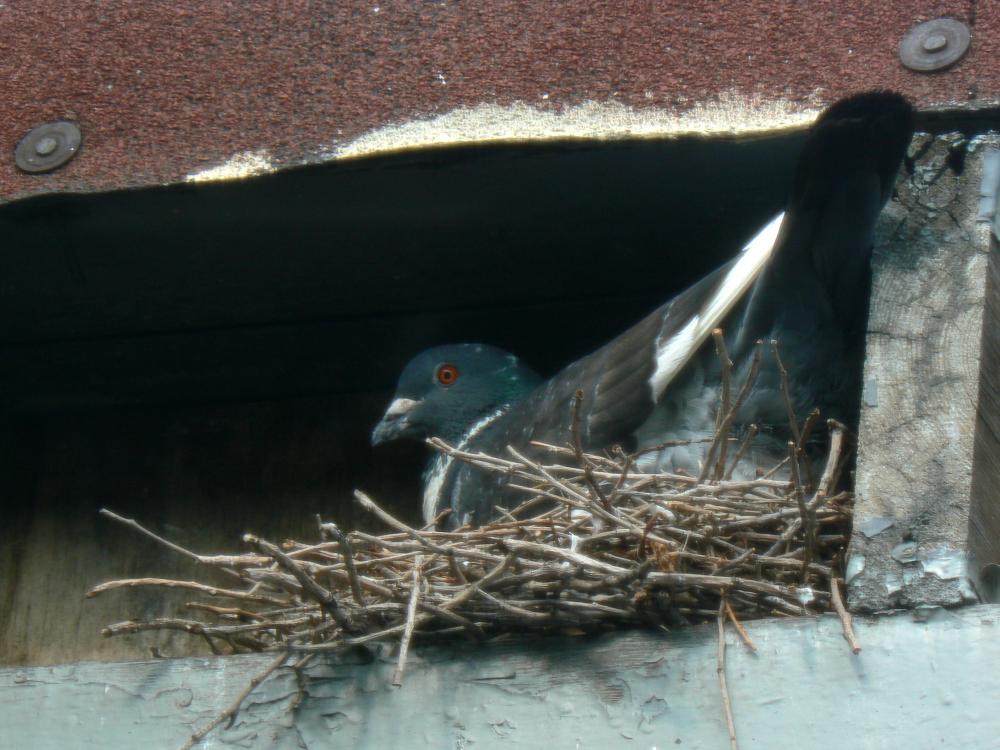
Nesting begins mid-February. Birds lay two eggs, and incubation begins after laying the second. Eggs are white and average 3.8 cm in length by 2.9 cm in width. Eggs typically hatch after 18 days, and chicks fledge on day 25–32. In some areas, Rock Pigeons can nest year- round due to chicks feeding on seeds and crop milk (a secretion from the crop of pigeons regurgitated to feed chicks). Mean number of nesting attempts per year is 6.5 (Lowther and Johnston, 2014). Adults are primarily granivorous (Wilman et al., 2014).
Native Species
Under the Migratory Bird Treaty Act, one cannot tamper with native bird nests or eggs. Therefore, with native species, prevention of nesting in undesirable areas and encouraging nesting in desirable areas is key (more details below).
The Barn Swallow is a species most growers love to see gliding effortlessly through the air eating pest insects (more information can be found here) but often causes disgruntlement due to its nesting habits. Historically a species that nested in caves, the Barn Swallow now primarily nests under the eaves of buildings or inside artificial structures (Fig. 7). Barn Swallows build open-cup nests from mud on the walls of structures. They often nest colonially (Brown and Brown, 1999). Pathogenic E. coli has been found in Barn Swallows (Nielsen et al., 2004), so nesting above food processing areas should be discouraged.
Barn Swallows have a vast global distribution, so there is considerable variation in life history attributes within the species. Birds typically begin nest-building within two weeks after returning to the breeding grounds (Brown and Brown, 1999). Females typically lay between 4–8 eggs (Shields and Crook, 1987). Eggs have an ovate to elliptical ovate shape and are creamy or pinkish white with brown, lavender, and gray spots. Egg size averages 1.9 cm long by 1.4 cm wide. Barn Swallows often have 2 broods per year but can have as many as 4. Incubation lasts about 12–17 days. Chicks fledge around day 18–27. For up to 2 weeks, fledglings rely on parents for feeding (Brown and Brown, 1999). Barn Swallows eat almost exclusively insects (Wilman et al., 2014; more information can be found here).
Historically, the Cliff Swallow nested colonially under ledges of canyons in the West (Fig. 8). Human land usage allowed a range expansion because modern highway culverts, bridges, and buildings became manmade “cliffs” for Cliff Swallows to build nests on (Brown et al., 2017). Like the Barn Swallow, the Cliff Swallow builds nests from mud, but unlike the Barn Swallow, the Cliff Swallow’s nest is enclosed and looks like a gourd (Fig. 8). Cliff Swallow colonies have been associated with increased environmental E. coli concentrations (Sejkora et al., 2011), so nesting should be discouraged above food packing areas.
Nest building typically begins within a few weeks of arrival to the breeding grounds. Arrival date and subsequent nest building varies by latitude and can start as early as March. The outside of nests are built entirely from mud, unlike Barn Swallow nests (Fig. 8), though birds do line the inside with grass. Clutch size varies from 1–6 eggs and averages about 3. Cliff Swallows usually have one brood but can have two if the first fails (Brown et al., 2017). Eggs are white, creamy, or pinkish with brown speckles or blotches. Cliff Swallow eggs average 2.0 cm in length by 1.4 cm in width. Incubation ranges from 11–16 days and averages around 13.6 (Grant and Quay, 1977). Chicks normally fledge between days 20–26, depending on the region. Fledglings rely on parents for food for the first 3–5 days (Brown et al., 2017). Like the Barn Swallow, Cliff Swallows eat almost exclusively insects (Wilman et al., 2014; more information can be found here).
The Black Phoebe (Fig. 10) has a small distribution within the continental United States but is frequently found on California organic farms foraging for insects. Natural nest sites include sheltered rock faces, streamside boulders, and hollow tree cavities. Like many other species in this article, human-built structures have increased densities of Black Phoebes by providing artificial nest sites. Black Phoebe nests (Fig. 11) appear quite similar to Barn Swallow nests. Nests are open cup, plastered to vertical surfaces, and composed of mud and plant material such as stems and small roots (Wolf, 1997). No current evidence has demonstrated Black Phoebes carry human enteric pathogens. However, Black Phoebes are known to frequent cattle troughs (Wolf, 1997), which is a known transmission point of human enteric pathogens between livestock and wild birds (Carlson et al., 2010). Therefore, growers should use caution due to little data existing on Black Phoebe pathogen rates.
Nest building typically begins in early March. Black Phoebes generally raise 1–2 broods per season with a clutch size of 1–6 eggs. Eggs are ovate to short ovate and white, sometimes with light spots around the large end. Eggs are typically 1.9 cm in length by 1.5 cm in width. Incubation averages 16–17 days. Chicks fledge between days 18–21. Fledglings are dependent on adults for the first 7–11 days (Wolf, 1997). Adults and chicks are almost exclusively insectivorous (Wilman et al., 2014).
The American Robin (Fig. 12) is, perhaps surprisingly, a thrush. To the disdain of many growers, its diet is largely comprised of beneficial invertebrates such as earthworms in the early breeding season, and switches to primarily fruits in fall and winter. It is adapted to live in many habitats and is common on farms and urban settings, as well as more forested settings like other thrushes (Vanderhoff et al., 2016). Like its habitat usage, its nest placement also has flexibility. Robins often place nests in shrubs, trees, or on structures, as long as the nest is on a firm support (Fig. 13). The nest is an open cup, constructed from mud, dead grass, and twigs on the outside, with a lining of fine dead grass pieces. One study found high prevalence of E. coli in American Robins (44.8%), though it did not distinguish pathogenic from non-pathogenic strains (Parker et al., 2016), so risk of American Robins carrying pathogenic E. coli is unclear. The USGS database Wildlife Health Information Sharing Partnership (WHISPers) reports several suspected cases of Salmonellosis in American Robins, suggesting they may vector Salmonella enterica to produce if allowed to nest near produce wash stations.
The American Robin is one of the most widely distributed species in North America, so onset of breeding varies by location, and occurs between April and June (Vanderhoff et al., 2016). Robins typically lay 3–4 eggs per clutch and have 2 broods per year. Eggs are a beautiful sky blue or green-blue color and average 2.8–3.0 cm in length by 2.1 cm in width (Fig. 14). The incubation period is generally 11–14 days (Howell, 1942). Nestlings typically fledge around day 13 after hatching (range 9–16 days; Howell, 1942). Parents typically begin a second brood within days of the first fledging. For the second clutch, once incubation begins, males feed fledglings while females incubate (Weatherhead and Mcrae, 1990).
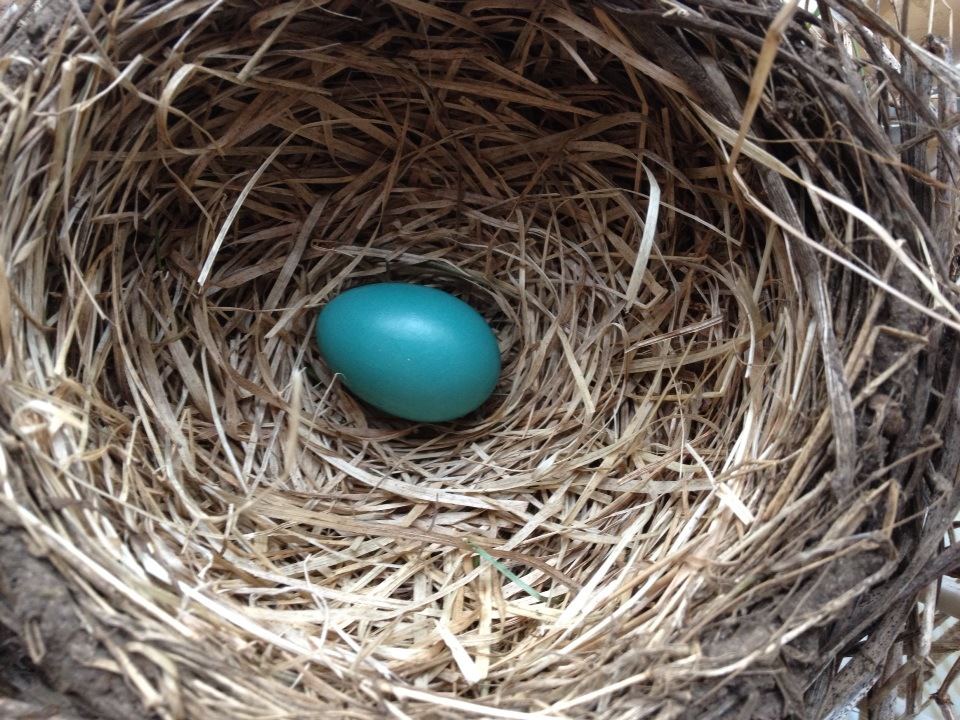
The House Finch (Fig. 15) is native to the deserts and dry, open habitats of the southwestern United States. In 1939, several birds were released from a pet store in New York City, allowing a range expansion into the eastern United States. The western population has also expanded its range so that now the House Finch occurs across most of the United States and Mexico. Nests can be placed in a large variety of sites: pine, palm trees, cacti, rock ledges, ivy on buildings, street lamps, hanging planters, parking structures, lean-tos, window sills, in the cavities of various farm equipment, etc. Nests are open cup and built from grass, leaves, rootlets, small twigs, string, wool, and feathers (Fig. 16). In urban areas, birds will incorporate human items such twine, string, dog hair, cellophane, and even cigarette filters (Badyaev et al., 2012). House Finches are known to carry E. coli (Morishita et al., 1999) and Salmonella enterica (Kirk et al., 2002), so nesting near food processing areas should be discouraged.
Nest building begins in February in the southwest portion of the range and March in the northern portion. Birds can nest up to 6 times per year but have only been observed to have 3 successful broods a season. Eggs are pale blue to white with black and pale purple speckles. Egg shape is sub-elliptical to long sub-elliptical and ranges from 1.6–2.1 cm in length by 1.2–1.8 cm in width. Incubation can take between 12–17 days and averages 13–14. Fledglings typically take 2.5–3 weeks to feed themselves completely independently from parents (Badyaev et al., 2012). Young are thought to eat mostly weed seeds with very little insect matter in the diet (<2%; Beal, 1907). House Finch adults are granivorous (Wilman et al., 2014).
Like the Barn Swallow, the Barn Owl (Fig. 17) has a nearly global distribution. It is typically found in open habitats such as pastures and farm fields rather than closed, forested habitats. Barn Owls are nocturnal and most likely to be seen around dawn and dusk. The Barn Owl has a piercing shriek (example recording here) that can also give away its occupancy. Barn Owls nest in cavities including tree cavities, cliffs, church steeples, barn lofts, haystacks, and nest boxes (Fig. 18). Suitable nesting locations is a limiting factor for this beneficial raptor, so providing nest boxes is important (Marti et al., 2005; click here for more information on construction and placement). Barn owls are known to carry Salmonella spp. (Kirkpatrick and Colvin, 1986), antibiotic resistant E. coli (Alcalá et al., 2016), and Campylobacter spp. (Molina-Lopez et al., 2011), perhaps from feeding on mice carrying these bacteria.
The Barn Owl does not usually build nests, though some dig burrows in arroyo walls in Colorado and New Mexico. Because of its wide distribution, egg laying initiation date varies and can occur year-round. One brood is common for birds in temperate regions, but some pairs have 3 broods per year. Average clutch size ranges from 3.1 to 7.2, depending on location. Eggs are short sub-elliptical, are about 3.2–3.4 cm in length by 4.0–4.4 cm in width, and dull white. The female incubates eggs for 29–34 days. Fledging date varies based on location. In England, first flight is usually day 50–55, whereas in Utah, mean fledging date is day 64. Fledglings are dependent on adults for 3–5 weeks. Fledglings are clumsy until they gain enough strength and agility to fly (Fig. 18). Chicks and adults eat the same diet, which is mostly small mammals, including common rodent pests (Moore et al., 1998; Marti et al., 2005; Wilman et al., 2014). However, evidence that Barn Owls increase yield through pest control services is still sparse (Moore et al., 1998), though Motro (2011) did find an estimated alfalfa yield increase of 3.2% due to Barn Owls, equating to $30/ha per year.
Nest Location Management
It is illegal to tamper with nests or eggs of native species, so deterrence of nesting in unwanted locations before it begins is important. Avoid using poisons or methods that can harm or kill native species. Below are a few commonly recommended methods for deterring bird nesting on structures. More research is needed to test the efficacy of listed methods. Most methods are best initiated and maintained prior to the onset of the breeding season.
- Block cavity entrances using mesh, wood, or other barriers (see nest in Fig. 2 above for an example this method could help with). Place netting carefully to avoid birds getting trapped inside (but see Fig. 4).
- Create slopes on ledges by placing boards at a 45 degree angle so that species like Rock Pigeon cannot build nests. If a board doesn’t work, try a loose spring that creates an unstable surface for birds to build on. Spikes are also an option, but be aware spikes can kill birds. A quick internet search shows many examples of nests built on top of spikes, suggesting they are ineffective, and will also show photos of impaled birds.
- Create a visual disturbance near nest sites by using flashing lights, placing mirrors on ledges, or hanging mylar tape. However, species like the European Starling are extremely smart and aren’t fooled for long with these methods (Belant et al., 1998).
- Place plastic predators near nests. These need to be moved frequently to continue to deter birds (Belant et al., 1998).
- Use noise machines that project bird distress or predator calls. However, there is no current evidence to suggest this method works.
- Plant shrubs that provide good nesting habitat away from structures. Try planting near crops where birds will eat pest insects (like apples; Mols and Visser, 2002), but avoid placing next to crops birds will damage (cherries, blueberries, grapes; Somers et al., 2002). Prior research has demonstrated pest control services increase near natural habitat like hedges (Boesing et al., 2017).
Find ways to encourage nesting at The Cornell Lab of Ornithology’s Project NestWatch website, which has excellent information on how to promote nesting for many species, including many farmland birds not listed in this article.
Source
Pigeon Patrol Products & Services is the leading manufacturer and distributor of bird deterrent (control) products in Canada. Pigeon Patrol products have solved pest bird problems in industrial, commercial, and residential settings since 2000, by using safe and humane bird deterrents with only bird and animal friendly solutions. At Pigeon Patrol, we manufacture and offer a variety of bird deterrents, ranging from Ultra-flex Bird Spikes with UV protection, Bird Netting, 4-S Bird Gel and the best Ultrasonic and audible sound devices on the market today.
Voted Best Canadian wholesaler for Bird Deterrent products ten years in a row.
Contact us at 1- 877– 4– NO-BIRD, (604) 585-9279 or visit our website at www.pigeonpatrol.ca
Pigeon/Pigeon Patrol / Pigeons Roosting / Vancouver Pigeon Control /Bird Spikes / Bird Control / Bird Deterrent / Pigeon Deterrent? Surrey Pigeon Control / Pest /Seagull deterrent / Vancouver Pigeon Blog / Birds Inside Home / Pigeons in the cities / Ice Pigeons/ What to do about pigeons/ sparrows , Damage by Sparrows, How To Keep Raccoons Away, Why Are Raccoons Considered Pests/ De-fence / Pigeon Nesting/ Bird Droppings / Pigeon Dropping/ woodpecker control/ Professional Bird Control Company/ Keep The Birds Away/ Birds/rats/ seagull/pigeon/woodpecker/ dove/sparrow/pidgeon control/pidgeon problem/ pidgeon control/flying rats/ pigeon Problems/ bird netting/bird gel/bird spray/bird nails/ bird guard

by Pigeon Patrol | Mar 29, 2022 | 4-S Gel Bird repellent, Animal Deterrent Products, Bird Deterrent Products, Bird Law, Bird Netting, Bird Spikes
Q. What can you tell me about pigeons’ nests? We just moved into a fifth floor apartment and there’s what looks like some kind of a bird’s nest on the ledge around our balcony, except it has sticks and debris in it. If it is a pigeon’s nest, will they come back to the same nest this year?
A. A ledge high on a building would be a typical nest site for pigeons (also called rock doves) since their natural nest site is in caves or crevices on rocky cliffs. In urban areas, pigeons nest in a variety of sites, but rarely in trees. Their only requirement is a dry, protected area and a flat surface upon which to nest and perch. Nests are usually high up on roofs, ledges, eaves, attics, or steeples, or under bridges or overpasses.
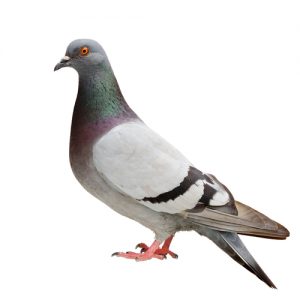 The male starts the nest building process by sitting on the nest site and calling for a mate. Once he has attracted a female to the site, he begins the search for nest material, bringing a single twig at a time to the female who tucks it in around her. During the day, the male sits on the completed nest that usually contains one or two eggs. The female takes over nest duties at night. Pigeons can nest year round and can produce up to 10 young a year.
The male starts the nest building process by sitting on the nest site and calling for a mate. Once he has attracted a female to the site, he begins the search for nest material, bringing a single twig at a time to the female who tucks it in around her. During the day, the male sits on the completed nest that usually contains one or two eggs. The female takes over nest duties at night. Pigeons can nest year round and can produce up to 10 young a year.
A pigeon’s nest is not a thing of beauty; it’s rather a mess. It’s made up of a conglomeration of sticks, small twigs, grass stems, pine needles, and debris — all piled together with a small cup depression in the center. Nests that are in continuous use are soon full of feathers and droppings. Unlike most other birds, pigeons do not remove the droppings of the young from the nest. The accumulated droppings tend to cement all of the nest materials together into a mound. And, yes, the pair usually does reuse the same nest site. They add new nest material right on top of the old sticks and droppings. Reused nests can even contain unhatched eggs and mummies of dead pigeon babies. Nests that have been reused for 3 to 4 years can be almost 8 inches high by 20 inches wide and can weigh more than 4 pounds!
You should discuss the problem with your property manager. You don’t want a pigeon’s nest on or near your balcony. The nest can harbor parasites such as bird mites and lice that can bite people. Droppings below the nest can deface the building, sidewalks, and cars, and large accumulations of droppings may contain disease organisms. Whoever removes the nest should wear gloves, and should discard the nest in a sealed plastic bag.
There are various types of deterrents and repellents that can be used to keep birds from nesting on the balconies or ledges of your building. A reputable pest control company that specializes in bird control can discuss the options.
Source
Pigeon Patrol Products & Services is the leading manufacturer and distributor of bird deterrent (control) products in Canada. Pigeon Patrol products have solved pest bird problems in industrial, commercial, and residential settings since 2000, by using safe and humane bird deterrents with only bird and animal friendly solutions. At Pigeon Patrol, we manufacture and offer a variety of bird deterrents, ranging from Ultra-flex Bird Spikes with UV protection, Bird Netting, 4-S Bird Gel and the best Ultrasonic and audible sound devices on the market today.
Voted Best Canadian wholesaler for Bird Deterrent products ten years in a row.
Contact us at 1- 877– 4– NO-BIRD, (604) 585-9279 or visit our website at www.pigeonpatrol.ca
Pigeon/Pigeon Patrol / Pigeons Roosting / Vancouver Pigeon Control /Bird Spikes / Bird Control / Bird Deterrent / Pigeon Deterrent? Surrey Pigeon Control / Pest /Seagull deterrent / Vancouver Pigeon Blog / Birds Inside Home / Pigeons in the cities / Ice Pigeons/ What to do about pigeons/ sparrows , Damage by Sparrows, How To Keep Raccoons Away, Why Are Raccoons Considered Pests/ De-fence / Pigeon Nesting/ Bird Droppings / Pigeon Dropping/ woodpecker control/ Professional Bird Control Company/ Keep The Birds Away/ Birds/rats/ seagull/pigeon/woodpecker/ dove/sparrow/pidgeon control/pidgeon problem/ pidgeon control/flying rats/ pigeon Problems/ bird netting/bird gel/bird spray/bird nails/ bird guard
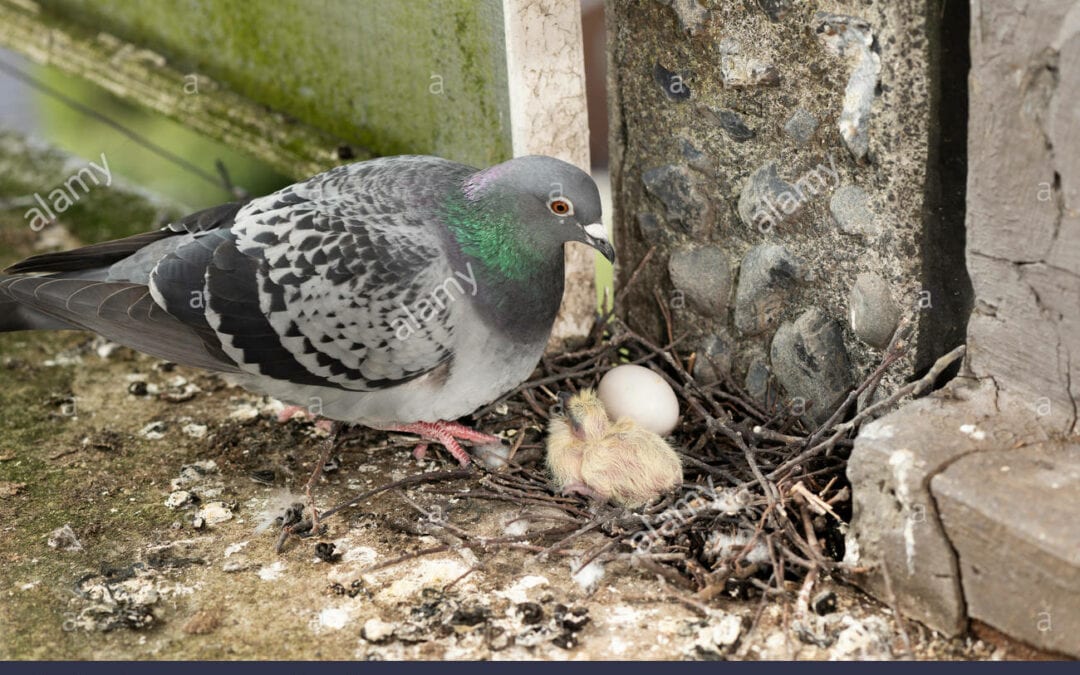
by Pigeon Patrol | Mar 21, 2022 | 4-S Gel Bird repellent, Animal Deterrent Products, Bird Deterrent Products, Bird Law, Bird Netting, Bird Spikes
The development of cities and urban sprawl has made room for wildlife inhabiting human environments. Among birds, feral pigeons (Columba livia domestica) are often present in large numbers in the cities. Problems related to pigeon occurrence result in economic loss and health issues for humans. There are different methods of controlling pigeon populations in urban areas. In this study, we compared three techniques that can be used for pigeon pest control. In two urban industrial sites in Hungary, we used trapping, falconry (in both Study Area 1 and 2) and mist-netting (only in Study Area 2) to remove pigeons. We compared the effectiveness and limitations of each method. Our results show that over 105 days in Study Area 1, we managed to remove 173 individual pigeons. We did not find a significant difference between the effectiveness of trapping or falconry. In Study Area 2, the overall number of pigeons removed was 1412 over a period of 150 days. There, we managed to catch significantly more birds by netting than by trapping or falconry, but the latter two did not differ statistically. We recommend a combination of techniques for pigeon control. Mist-netting can be the most effective way for direct pigeon removal, whereas trapping is an easier but less efficient method to catch pigeons. Falconry is the least efficient in pigeon catching and requires the most investments, but the bird of prey may chase the pigeons away for a short time.
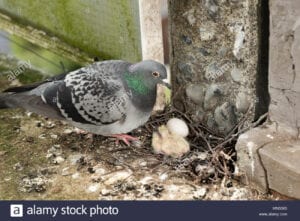
Source
Pigeon Patrol Products & Services is the leading manufacturer and distributor of bird deterrent (control) products in Canada. Pigeon Patrol products have solved pest bird problems in industrial, commercial, and residential settings since 2000, by using safe and humane bird deterrents with only bird and animal friendly solutions. At Pigeon Patrol, we manufacture and offer a variety of bird deterrents, ranging from Ultra-flex Bird Spikes with UV protection, Bird Netting, 4-S Bird Gel and the best Ultrasonic and audible sound devices on the market today.
Voted Best Canadian wholesaler for Bird Deterrent products ten years in a row.
Contact us at 1- 877– 4– NO-BIRD, (604) 585-9279 or visit our website at www.pigeonpatrol.ca
Pigeon/Pigeon Patrol / Pigeons Roosting / Vancouver Pigeon Control /Bird Spikes / Bird Control / Bird Deterrent / Pigeon Deterrent? Surrey Pigeon Control / Pest /Seagull deterrent / Vancouver Pigeon Blog / Birds Inside Home / Pigeons in the cities / Ice Pigeons/ What to do about pigeons/ sparrows , Damage by Sparrows, How To Keep Raccoons Away, Why Are Raccoons Considered Pests/ De-fence / Pigeon Nesting/ Bird Droppings / Pigeon Dropping/ woodpecker control/ Professional Bird Control Company/ Keep The Birds Away/ Birds/rats/ seagull/pigeon/woodpecker/ dove/sparrow/pidgeon control/pidgeon problem/ pidgeon control/flying rats/ pigeon Problems/ bird netting/bird gel/bird spray/bird nails/ bird guard
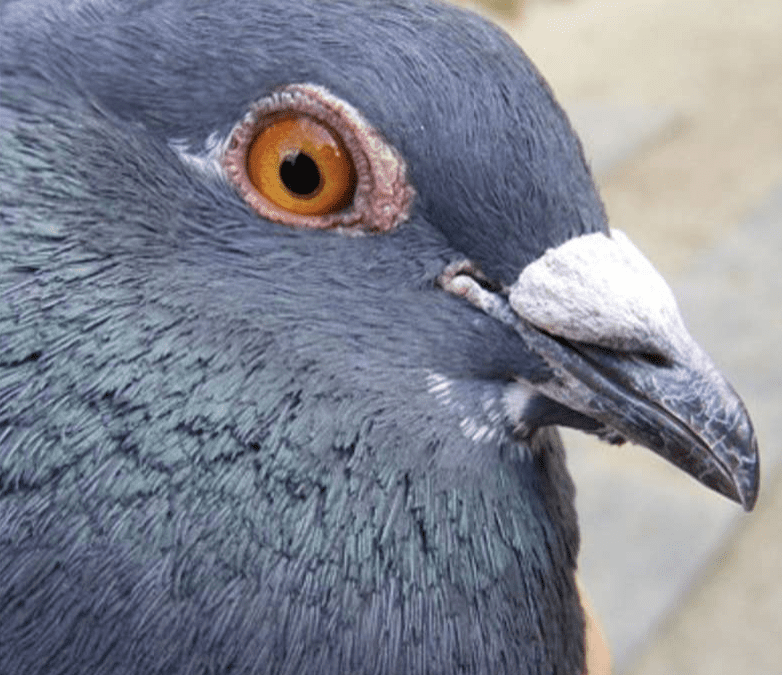
by Pigeon Patrol | Mar 7, 2022 | 4-S Gel Bird repellent, Animal Deterrent Products, Bird Deterrent Products, Bird Law, Bird Netting, Bird Spikes
Being a peregrine fanatic I’m kind of fond of pigeons – at least from the prey point of view – so when I was in downtown Pittsburgh on Sunday I stopped by Mellon Square to check out the scene.
Even for a peregrine falcon the number of pigeons at Mellon Square is way too much of a good thing. I counted more than 150 and I couldn’t see all of them. The pigeons outnumbered people more than 30 to 1.
This explains why peregrines hang out on the Oliver Building window sills. It’s like visiting an all-you-can-eat restaurant. The food may not be that great but there’s so much of it!
This kind of pigeon over-population repulses most people and they want a quick fix, the quickest being poison. But if you poison a pigeon, you’ll poison a peregrine. After a culling episode pigeons reproduce fast to fill the void – in fact lethal control actually increases the flock – but the peregrines take years to recover. And peregrines are endangered in Pennsylvania. It’s bad, bad, bad to poison an endangered species.
So what to do?
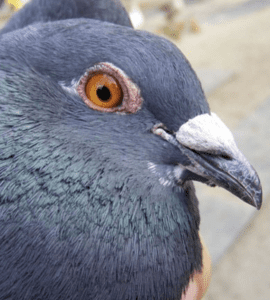
Pigeons need two things to reach the numbers found at Mellon Square: lots of food and places to nest. They reproduce in direct proportion to their food supply. If food is scarce some won’t nest at all. If food is plentiful they lay the next clutch of eggs before the first set has hatched, producing more than 12 chicks per year.
The food problem is obvious. Sidewalks at Mellon Square are coated with bird seed. Control the food source (the people who feed them) and you’ve got most of the problem licked. To make a really dramatic difference, control the nest sites as well.
City pigeons nest on buildings and bridges. They also nest in buildings. Find the buildings involved and spend the time and money to block the access holes. Last summer the University of Pittsburgh cleaned the Cathedral of Learning and blocked off the pigeon nest holes as part of the cleaning job. One year later there are far fewer pigeons at Schenley Plaza.
And finally, there’s a foolproof solution that makes both the pigeon-feeders and the pigeon-haters happy. Many European cities have solved their pigeon problem permanently by building dovecotes and pigeon lofts. Yes, they built nest sites. They control the population at the dovecotes by substituting dummy eggs and they control the food level by giving pigeon lovers an approved place to feed and interact with the birds.
This keeps the pigeons and the birdseed off the street. An elegant solution.
Source
Pigeon Patrol Products & Services is the leading manufacturer and distributor of bird deterrent (control) products in Canada. Pigeon Patrol products have solved pest bird problems in industrial, commercial, and residential settings since 2000, by using safe and humane bird deterrents with only bird and animal friendly solutions. At Pigeon Patrol, we manufacture and offer a variety of bird deterrents, ranging from Ultra-flex Bird Spikes with UV protection, Bird Netting, 4-S Bird Gel and the best Ultrasonic and audible sound devices on the market today.
Voted Best Canadian wholesaler for Bird Deterrent products ten years in a row.
Contact us at 1- 877– 4– NO-BIRD, (604) 585-9279 or visit our website at www.pigeonpatrol.ca
Pigeon/Pigeon Patrol / Pigeons Roosting / Vancouver Pigeon Control /Bird Spikes / Bird Control / Bird Deterrent / Pigeon Deterrent? Surrey Pigeon Control / Pest /Seagull deterrent / Vancouver Pigeon Blog / Birds Inside Home / Pigeons in the cities / Ice Pigeons/ What to do about pigeons/ sparrows , Damage by Sparrows, How To Keep Raccoons Away, Why Are Raccoons Considered Pests/ De-fence / Pigeon Nesting/ Bird Droppings / Pigeon Dropping/ woodpecker control/ Professional Bird Control Company/ Keep The Birds Away/ Birds/rats/ seagull/pigeon/woodpecker/ dove/sparrow/pidgeon control/pidgeon problem/ pidgeon control/flying rats/ pigeon Problems/ bird netting/bird gel/bird spray/bird nails/ bird guard
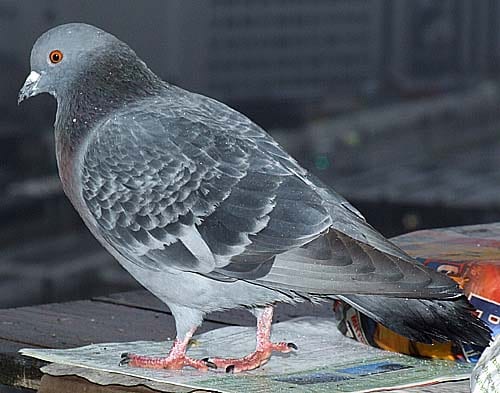
by Pigeon Patrol | Feb 22, 2022 | 4-S Gel Bird repellent, Animal Deterrent Products, Bird Deterrent Products, Bird Law, Bird Netting
Anyone who has lived in an urban environment has seen stringfoot pigeons; many wonder how the feet of these birds come to be bound and twisted, but few people seem to realize that something can be done to alleviate the suffering of these beautiful birds. Although I am a recent arrival to the world of destringing pigeons, this practice is certainly not a new phenomenon. The most perfunctory online search reveals a variety of stories from at least the last few decades of individuals who undertake pigeon destringing, and there are undoubtedly countless other individuals whose destringing activities have gone completely unnoticed and unheralded.
Not long ago I came across the intriguing case of British author and critic Naomi Lewis, noted for her animal advocacy and her pigeon rescue efforts. It isn’t clear precisely when her pigeon destringing efforts started. She moved with her family to London’s Red Lion Square in 1935 and lived there until her death in 2009; her apartment became a haven for injured creatures and famously off limits to visitors, although “she was once observed releasing a convalescent pigeon from one of the windows.”[i]An article from the London Times in 1995 commented on the plight of stringfoot pigeons in the city, and on Lewis’ activities — when the article was written, Lewis was already in her 80s: “The writer Naomi Lewis goes round London with a small pair of scissors especially to help them. She has become expert at spotting pigeons in this plight, pouncing on them, picking them up, and cutting them free.”[ii]More recently, an author once acquainted with Lewis noted her passion for rescuing stringfoot pigeons: “Luckily for them, she knew where they were. During her hours of cycling around and wandering the streets, distributing bird seed, she had learned where the crippled ones lived. Imagine her patience – the endless searching, trudging, scattering, waiting, day after day, until she eventually caught them.”[iii]The image of Lewis, an elderly, “diminutive, velvet-clad woman,”[iv]bicycling and trudging about London in search of stringfoot pigeons is compelling and inspiring. Perhaps part of what draws me to the story of Lewis is that articles that mention her (including her obituaries) suggest, in the nicest way possible, that she was quite an eccentric, and her attraction to urban pigeons seems to be one of the factors that contributed to this assessment of her character. We who love pigeons are keenly aware that this love is often equated with eccentricity.
Judging by the reactions I have seen among people on the street who witness the process of pigeon destringing, it is an activity generally perceived as eccentric, and at first the reasons it is needed and done are difficult for observers to grasp. But once these somewhat confused and often skeptical bystanders understand what is going on and why, they are just as often supportive of efforts on behalf of pigeons and some are even anxious to participate. The evidence before their eyes helps to convince observers of both the beauty of these birds and our responsibility to help them. The destringing of urban pigeons can be seen as much more, therefore, than simply an effort to assist wild creatures to have lives free of suffering. It is one more way that we pigeon champions can help to normalize the public perception of all pigeons as valued and valuable creatures.
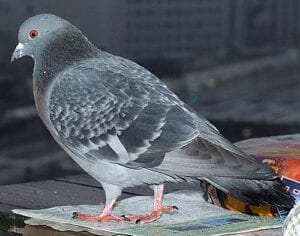
The Destringing Process in Action
What is the experience of destringing a pigeon like, and how is it done? There are many others who have been destringing for years, have handled countless stringfoot pigeons, and are so much more well-qualified than I to discuss this experience. With apologies, therefore, for my inexperience, I’d like to recount one of my own destringing experiences in San Francisco as a way of introducing the destringing process in general.
- Finding a stringfoot pigeon
Last week, a Muni failure forced me off the train at Church and Duboce. I had my destringing kit with me; I was headed for the Embarcadero, where there is a large population of stringfoot pigeons. Walking towards Market Street, I passed the Safeway parking lot and caught a glimpse of a pigeon flock there, browsing, preening, and flirting. Just in case, I stopped to check on them — and immediately spotted a beautiful white and grey girl with string on her feet, her feet bound together, barely able to walk.
- Catching the stringfoot pigeon
A crucial aspect of the destringing process is, of course, catching the pigeon. This is an acquired skill (one I am still working on), that requires much practice and patience. For those living in cities that are fortunate enough to have Stringfoot Pigeon groups, one of the best ways to learn how to catch pigeons is one-on-one expert coaching. Destringers seem to each develop their own approach to catching birds. For myself, I find that the position and disposition of the pigeon are the most important factors. I have the greatest likelihood of success if the pigeon is facing towards me (can’t easily fly away); is hemmed in by other birds; and has shifted its attention from me to the food I am dropping. After three tries and almost giving up all hope, I managed to catch this white and grey stringfoot girl.
- Destringing
The actual destringing can range from a simple process, when the string or hair is easy to see, loosely wound, and easily removed, to a monumental challenge when the material is voluminous, woven in complex layers, deeply embedded in the foot, or has already caused a lot of tissue damage and deformity. Although each case is very different, at the most basic level the process involves spraying the foot with something like Vetricyn to clean, loosen, and soften the fibers, dirt, and any dead tissue; and then very gently loosening, cutting, and unwinding fibers from the foot. Unwinding when possible instead of simply cutting helps to ensure that no hair or thread remains embedded in the skin. Fortunately for me and for this pretty pigeon, her string — which looked like a combination of twine and dental floss — was easy to see and remove, although cutting into her foot quite deeply.
- Releasing the pigeon
Of course, once the pigeon’s feet are free and disinfected, the pigeon should be released back where caught and, if possible, in sight of her flock, who she will want to join quickly in order to recount her unpleasant adventure.
- Why we do it, when we shouldn’t, and how you can help
One of the factors that motivates me to destring stringfoot pigeons seems so self-evident that it almost goes without saying: these pigeons cannot remove string from their own feet. If you take a moment to really consider this simple fact, however, the enormity of it can be overwhelming. To realize this fact is to accept the knowledge that each and every stringfoot pigeon will live their entire lives in ever-increasing pain, acquiring infections, losing digits and feet, and becoming unable to perform the basic activities required to live, unless a human sees their need, picks them up, and frees their feet.
Alongside the recognition of this need, destringers also have to realize their own limitations. Even in the brief time I have been destringing, I have seen heartbreaking examples of pigeons with deformed and painful stringfeet who I simply could not catch. The numerous destringers who have more experience than I must have countless such stories. Jodie Foreman, who started the “San Francisco Pigeons – Stringfoot help” group and several groups in other US cities, told me that when she is out but does not have her destringing kit with her, she tries to resist looking at pigeons (I believe she now carries her kit at all times!). Although it is hard to resist, there is no advantage to catching a stringfoot pigeon if one is unprepared to destring, and destringers advocate against removing any pigeon from its flock, its mate, and possibly its babies.
There are many resources available for anyone interested in helping to free the feet of these beautiful birds. The facebook group “San Francisco Pigeons – Stringfoot help” (and groups in Denver, Chicago, Washington, Seattle, and Los Angeles) provides a wealth of information about finding, catching, destringing, and the complex issues that can arise in the destringing process. Experienced destringers on these forums give generously of their time to answer questions, give advice, and provide training.
There are few forms of wildlife rescue that demand as little from the rescuer as destringing stringfoot pigeons. If you are willing to do some research, buy a handful of supplies, and you have a bit of time, you can doubtless find stringfoot pigeons in need of help near you, regardless of where you are. And it is difficult to imagine another rescue activity that can provide the same level of instantly transformative relief from pain and disability, and lasting impact on quality of life, as freeing the feet of these gentle and beautiful creatures.
Source
Pigeon Patrol Products & Services is the leading manufacturer and distributor of bird deterrent (control) products in Canada. Pigeon Patrol products have solved pest bird problems in industrial, commercial, and residential settings since 2000, by using safe and humane bird deterrents with only bird and animal friendly solutions. At Pigeon Patrol, we manufacture and offer a variety of bird deterrents, ranging from Ultra-flex Bird Spikes with UV protection, Bird Netting, 4-S Bird Gel and the best Ultrasonic and audible sound devices on the market today.
Voted Best Canadian wholesaler for Bird Deterrent products ten years in a row.
Contact us at 1- 877– 4– NO-BIRD, (604) 585-9279 or visit our website at www.pigeonpatrol.ca
Pigeon/Pigeon Patrol / Pigeons Roosting / Vancouver Pigeon Control /Bird Spikes / Bird Control / Bird Deterrent / Pigeon Deterrent? Surrey Pigeon Control / Pest /Seagull deterrent / Vancouver Pigeon Blog / Birds Inside Home / Pigeons in the cities / Ice Pigeons/ What to do about pigeons/ sparrows , Damage by Sparrows, How To Keep Raccoons Away, Why Are Raccoons Considered Pests/ De-fence / Pigeon Nesting/ Bird Droppings / Pigeon Dropping/ woodpecker control/ Professional Bird Control Company/ Keep The Birds Away/ Birds/rats/ seagull/pigeon/woodpecker/ dove/sparrow/pidgeon control/pidgeon problem/ pidgeon control/flying rats/ pigeon Problems/ bird netting/bird gel/bird spray/bird nails/ bird guard







 The male starts the nest building process by sitting on the nest site and calling for a mate. Once he has attracted a female to the site, he begins the search for nest material, bringing a single twig at a time to the female who tucks it in around her. During the day, the male sits on the completed nest that usually contains one or two eggs. The female takes over nest duties at night. Pigeons can nest year round and can produce up to 10 young a year.
The male starts the nest building process by sitting on the nest site and calling for a mate. Once he has attracted a female to the site, he begins the search for nest material, bringing a single twig at a time to the female who tucks it in around her. During the day, the male sits on the completed nest that usually contains one or two eggs. The female takes over nest duties at night. Pigeons can nest year round and can produce up to 10 young a year.




